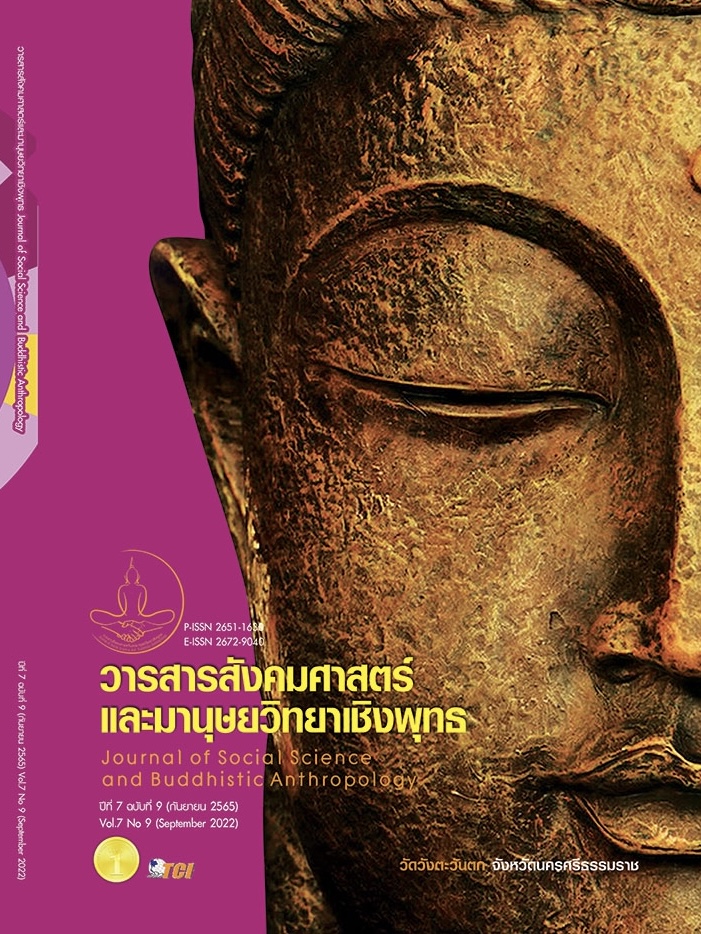PARAPROFESSIONAL COLLABORATIVE TEAM MODELS IN EARLY INTERVENTION FOR INDIVIDUALS WITH MULTIPLE DISABILITIES AT THE CHIANG RAI SPECIAL EDUCATION CENTER
Keywords:
Collaborative team models, Early Intervention, Paraprofessionals, Multiple disabilities, Special Education CenterAbstract
The objectives of this research article were to examine the utilization and described suggestions of four different paraprofessional collaborative team models in early intervention for individuals with multiple disabilities at the Chiang Rai Special Education Center which was the mixed methods research. A sample of 39 participants included parents, special education teachers, occupational therapists, physical therapists, Clinical Psychologists and a Thai traditional medicine specialist, all were chosen by purposive sampling. Research instruments consisted of, 1) a questionnaire and 2) a focus group form. Data were collected between May - October 2021. The study results were analyzed and reported using frequencies, percentages, means, standard deviation, and content analysis. The research revealed that: 1) Of the four collaborative team models, about 44.44% of the participants indicated that they utilized the Interdisciplinary Team (Model no.2) at work, while 41.67% preferred to use the Transdisciplinary Team (Model no.3). The professional participants in the study followed all seven step processes of early intervention when providing services to individuals with multiple disabilities. Overall, the practice of early intervention service was rated as high. (66.67%).The highest rated practice steps by 75% of the participants were step 5 (or providing appropriate activities) and step six (or progress evaluation), while the lowest rated practice by 52.78 % was step three (or the assessment). 2) To better serve individuals with multiple disabilities and their families who live in remote and up to the high hill areas of Chiang Rai, the majority of the participants (77.77%) suggested that; 1) the special education center should increase the numbers of staff and a variety of paraprofessionals in order to be suitable for workload and travel time. 2) more paraprofessionals’ team effort was needed. And 3) collaborative team planning efforts with the same goals was accounted as a percentage of 77.77, 75 and 66.66 respectively.
References
กระทรวงศึกษาธิการ. (2551). พระราชบัญญัติการจัดการศึกษาสำหรับคนพิการ พ.ศ. 2551. กรุงเทพมหานคร: สำนักนายกรัฐมนตรี.
กานดา โต๊ะถม. (2551). คู่มือการช่วยเหลือระยะแรกเริ่ม (Early Intervention: EI) เด็กพิการสำหรับโรงเรียนเฉพาะความพิการและศูนย์การศึกษาพิเศษ. กรุงเทพมหานคร: สำนักงานคณะกรรมการการศึกษาขั้นพื้นฐาน.
กุลยา ก่อสุวรรณ, และยวุดี วิริยางกูร. (2560). การสอนและการช่วยเหลือบุคคลที่มีความบกพร่องทางสติปัญญาและเรียนรู้ช้า (ฉบับปรับปรุงครั้งที่2). เชียงใหม่: มหาวิทยาลัยเชียงใหม่.
จักรพงศ์ หมื่นสุ. (2564). การมีส่วนร่วมรับผิดชอบระหว่างผู้ปกครองกับนักสหวิชาชีพในการใช้เทคโนโลยี สิ่งอำนวยความสะดวกเพื่อพัฒนาทักษะการรับประทานอาหารของเด็กที่มีภาวะพาทัวชินโดรม. ใน วิทยานิพนธ์ศึกษาศาสตรมหาบัณฑิต สาขาการศึกษาพิเศษ. มหาวิทยาลัยเชียงใหม่.
ประกาศกระทรวงศึกษาธิการ เรื่อง กำหนดประเภทและหลักเกณฑ์ของคนพิการทางการศึกษา พ.ศ. 2552. (2552). ราชกิจจานุเบกษา เล่มที่ 126 ตอนพิเศษ 80 ง หน้า 45 - 47 (8 มิถุนายน 2552).
มัทนา บั้งเงิน. (2558). บทบาทของผู้ปกครองนักสหวิชาชีพและผู้นำชุมชนในการช่วยเหลือฟื้นฟูสมรรถภาพคนพิการโดยชุมชน. ใน วิทยานิพนธ์ศึกษาศาสตรมหาบัณฑิต สาขาการศึกษาพิเศษ. มหาวิทยาลัยเชียงใหม่.
รัฐธรรมนูญแห่งราชอาณาจักรไทย พ.ศ. 2560. (2560). ราชกิจจานุเบกษา เล่มที่ 134 ตอนที่ 40 ก หน้า 13.(6 เมษายน 2560).
รุ่งทิวา ไชยชมภู. (2564). โอกาสและการเข้าถึงการศึกษาของบุคคลพิการซ้อน. ใน วิทยานิพนธ์ศึกษาศาสตรมหาบัณฑิต สาขาการศึกษาพิเศษ. มหาวิทยาลัยเชียงใหม่.
สามารถ รัตนสาคร. (2555). คู่มือการสอนนักเรียนที่มีความบกพร่องทางการเห็นและมีความพิการซ้อน. กรุงเทพมหานคร: สำนักบริหารงานการศึกษาพิเศษ.
สำนักบริหารงานการศึกษาพิเศษ. (2551). คู่มือการให้บริการช่วยเหลือระยะแรกเริ่มสำหรับโรงเรียนเฉพาะความพิการและศูนย์การศึกษาพิเศษ. กรุงเทพมหานคร: สำนักงานพุทธศาสนาแห่งชาติ.
Crais, E. R. (2006). Parents’ and Professionals’ Perceptions of the Implementation of Family - Centered Practices in Child Assessments. USA: University of North Carolina.
Decoster, D. (2009). Early intervention in the home for children under the age of threewith developmental delays: An in - depth examination of the interaction betweenservice
providers and family members. USA: California State University.
O’Shea, L. et al. (2001). Families and Teachers of Individuals with Disabilities. Boston: Allyn & Bacon.
Downloads
Published
How to Cite
Issue
Section
License
Copyright (c) 2022 Journal of Social Science and Buddhistic Anthropology

This work is licensed under a Creative Commons Attribution-NonCommercial-NoDerivatives 4.0 International License.








